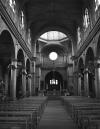Resumo
Las misiones de Chiloé mantienen vigente el legado de los jesuitas; se caracterizan por conservar el uso religioso que las originó, como también una serie de estructuras sociales en las comunidades. De esta manera, nos enfrentamos a un patrimonio vivo y a una cultura muy particular. Las intervenciones realizadas en estas iglesias se fundamentan en valores intangibles, pero se materializan en hechos concretos. El trabajo realizado sobre las iglesias de Chiloé intenta seguir el camino hacia la búsqueda de una cultura de la conservación, con la participación y esfuerzos de muchas personas e instituciones que han permitido ir recuperando este patrimonio. El proyecto y la obra de conservación o de restauración sobre edificios preexistentes es mucho más que un problema técnico arquitectónico; aunque se trabaja en objetos materiales y aparentemente son soluciones constructivas, lo más relevante es que estas soluciones sean respuestas coherentes a los valores que representan los bienes culturales, muchas veces expresiones tangibles e intangibles de un grupo humano que se van depositando a través del tiempo, como pueden ser visiones del mundo, intereses espirituales, reglas estéticas, técnicas constructivas, etc.; en definitiva, el saber hacer y el conocimiento acumulado de una sociedad. Esto es lo que interesa rescatar. En suma es buscar el diálogo entre lo nuevo y lo viejo, la tradición y la modernidad, lo local y lo global, lo ilustrado y lo popular, lo tangible y lo intangible, el pasado, el presente y el futuro de un pueblo y sus creencias.
La revista Apuntes se encuentra registrada bajo la licencia Creative Commons Reconocimiento 4.0 Internacional. Por lo tanto, esta obra se puede reproducir, distribuir y comunicar públicamente en formato digital, siempre que se reconozca el nombre de los autores y a la Pontificia Universidad Javeriana. Se permite citar, adaptar, transformar, autoarchivar, republicar y crear a partir del material, para cualquier finalidad (incluso comercial), siempre que se reconozca adecuadamente la autoría, se proporcione un enlace a la obra original y se indique si se han realizado cambios. La Pontificia Universidad Javeriana no retiene los derechos sobre las obras publicadas y los contenidos son responsabilidad exclusiva de los autores, quienes conservan sus derechos morales, intelectuales, de privacidad y publicidad.
El aval sobre la intervención de la obra (revisión, corrección de estilo, traducción, diagramación) y su posterior divulgación se otorga mediante una licencia de uso y no a través de una cesión de derechos, lo que representa que la revista y la Pontificia Universidad Javeriana se eximen de cualquier responsabilidad que se pueda derivar de una mala práctica ética por parte de los autores. En consecuencia de la protección brindada por la licencia de uso, la revista no se encuentra en la obligación de publicar retractaciones o modificar la información ya publicada, a no ser que la errata surja del proceso de gestión editorial. La publicación de contenidos en esta revista no representa regalías para los contribuyentes.


